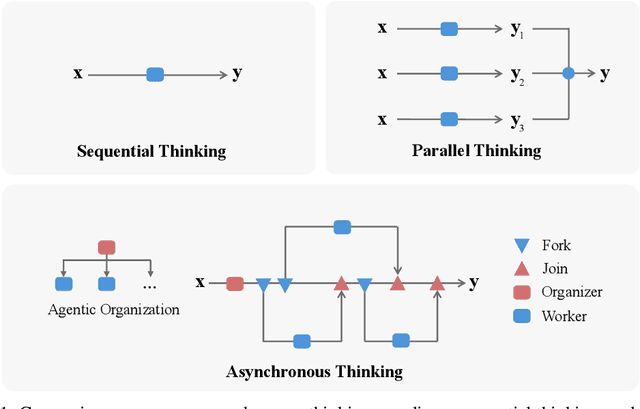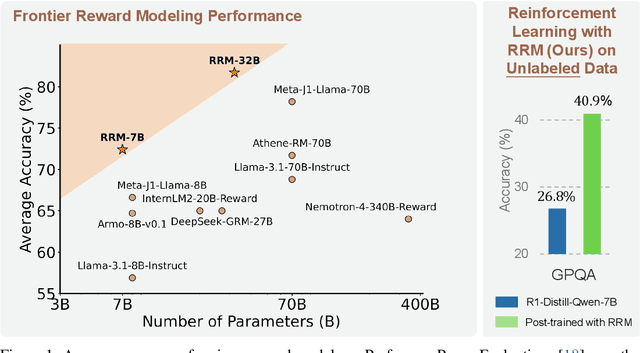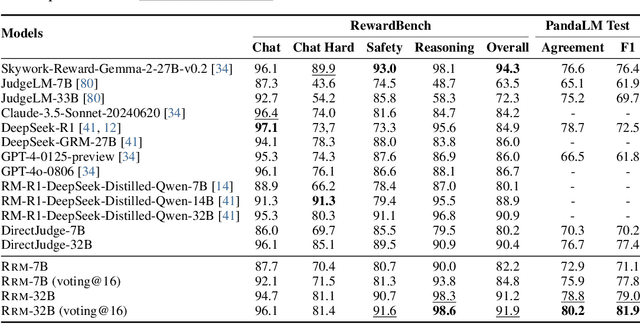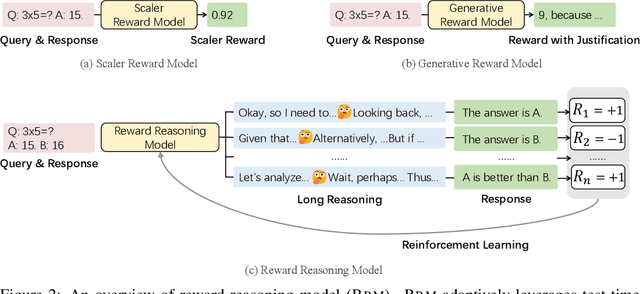Shaohan Huang
The Era of Agentic Organization: Learning to Organize with Language Models
Oct 30, 2025



Abstract:We envision a new era of AI, termed agentic organization, where agents solve complex problems by working collaboratively and concurrently, enabling outcomes beyond individual intelligence. To realize this vision, we introduce asynchronous thinking (AsyncThink) as a new paradigm of reasoning with large language models, which organizes the internal thinking process into concurrently executable structures. Specifically, we propose a thinking protocol where an organizer dynamically assigns sub-queries to workers, merges intermediate knowledge, and produces coherent solutions. More importantly, the thinking structure in this protocol can be further optimized through reinforcement learning. Experiments demonstrate that AsyncThink achieves 28% lower inference latency compared to parallel thinking while improving accuracy on mathematical reasoning. Moreover, AsyncThink generalizes its learned asynchronous thinking capabilities, effectively tackling unseen tasks without additional training.
Towards Stable and Effective Reinforcement Learning for Mixture-of-Experts
Oct 27, 2025Abstract:Recent advances in reinforcement learning (RL) have substantially improved the training of large-scale language models, leading to significant gains in generation quality and reasoning ability. However, most existing research focuses on dense models, while RL training for Mixture-of-Experts (MoE) architectures remains underexplored. To address the instability commonly observed in MoE training, we propose a novel router-aware approach to optimize importance sampling (IS) weights in off-policy RL. Specifically, we design a rescaling strategy guided by router logits, which effectively reduces gradient variance and mitigates training divergence. Experimental results demonstrate that our method significantly improves both the convergence stability and the final performance of MoE models, highlighting the potential of RL algorithmic innovations tailored to MoE architectures and providing a promising direction for efficient training of large-scale expert models.
VibeVoice Technical Report
Aug 26, 2025Abstract:This report presents VibeVoice, a novel model designed to synthesize long-form speech with multiple speakers by employing next-token diffusion, which is a unified method for modeling continuous data by autoregressively generating latent vectors via diffusion. To enable this, we introduce a novel continuous speech tokenizer that, when compared to the popular Encodec model, improves data compression by 80 times while maintaining comparable performance. The tokenizer effectively preserves audio fidelity while significantly boosting computational efficiency for processing long sequences. Thus, VibeVoice can synthesize long-form speech for up to 90 minutes (in a 64K context window length) with a maximum of 4 speakers, capturing the authentic conversational ``vibe'' and surpassing open-source and proprietary dialogue models.
VisCodex: Unified Multimodal Code Generation via Merging Vision and Coding Models
Aug 13, 2025Abstract:Multimodal large language models (MLLMs) have significantly advanced the integration of visual and textual understanding. However, their ability to generate code from multimodal inputs remains limited. In this work, we introduce VisCodex, a unified framework that seamlessly merges vision and coding language models to empower MLLMs with strong multimodal code generation abilities. Leveraging a task vector-based model merging technique, we integrate a state-of-the-art coding LLM into a strong vision-language backbone, while preserving both visual comprehension and advanced coding skills. To support training and evaluation, we introduce the Multimodal Coding Dataset (MCD), a large-scale and diverse collection of 598k samples, including high-quality HTML code, chart image-code pairs, image-augmented StackOverflow QA, and algorithmic problems. Furthermore, we propose InfiBench-V, a novel and challenging benchmark specifically designed to assess models on visually-rich, real-world programming questions that demand a nuanced understanding of both textual and visual contexts. Extensive experiments show that VisCodex achieves state-of-the-art performance among open-source MLLMs and approaches proprietary models like GPT-4o, highlighting the effectiveness of our model merging strategy and new datasets.
Geometric-Mean Policy Optimization
Jul 28, 2025Abstract:Recent advancements, such as Group Relative Policy Optimization (GRPO), have enhanced the reasoning capabilities of large language models by optimizing the arithmetic mean of token-level rewards. However, GRPO suffers from unstable policy updates when processing tokens with outlier importance-weighted rewards, which manifests as extreme importance sampling ratios during training, i.e., the ratio between the sampling probabilities assigned to a token by the current and old policies. In this work, we propose Geometric-Mean Policy Optimization (GMPO), a stabilized variant of GRPO. Instead of optimizing the arithmetic mean, GMPO maximizes the geometric mean of token-level rewards, which is inherently less sensitive to outliers and maintains a more stable range of importance sampling ratio. In addition, we provide comprehensive theoretical and experimental analysis to justify the design and stability benefits of GMPO. Beyond improved stability, GMPO-7B outperforms GRPO by an average of 4.1% on multiple mathematical benchmarks and 1.4% on multimodal reasoning benchmark, including AIME24, AMC, MATH500, OlympiadBench, Minerva, and Geometry3K. Code is available at https://github.com/callsys/GMPO.
Reasoning with Exploration: An Entropy Perspective
Jun 17, 2025Abstract:Balancing exploration and exploitation is a central goal in reinforcement learning (RL). Despite recent advances in enhancing language model (LM) reasoning, most methods lean toward exploitation, and increasingly encounter performance plateaus. In this work, we revisit entropy -- a signal of exploration in RL -- and examine its relationship to exploratory reasoning in LMs. Through empirical analysis, we uncover strong positive correlations between high-entropy regions and three types of exploratory reasoning actions: (1) pivotal tokens that determine or connect logical steps, (2) reflective actions such as self-verification and correction, and (3) rare behaviors under-explored by the base LMs. Motivated by this, we introduce a minimal modification to standard RL with only one line of code: augmenting the advantage function with an entropy-based term. Unlike traditional maximum-entropy methods which encourage exploration by promoting uncertainty, we encourage exploration by promoting longer and deeper reasoning chains. Notably, our method achieves significant gains on the Pass@K metric -- an upper-bound estimator of LM reasoning capabilities -- even when evaluated with extremely large K values, pushing the boundaries of LM reasoning.
On-Policy RL with Optimal Reward Baseline
May 29, 2025Abstract:Reinforcement learning algorithms are fundamental to align large language models with human preferences and to enhance their reasoning capabilities. However, current reinforcement learning algorithms often suffer from training instability due to loose on-policy constraints and computational inefficiency due to auxiliary models. In this work, we propose On-Policy RL with Optimal reward baseline (OPO), a novel and simplified reinforcement learning algorithm designed to address these challenges. OPO emphasizes the importance of exact on-policy training, which empirically stabilizes the training process and enhances exploration. Moreover, OPO introduces the optimal reward baseline that theoretically minimizes gradient variance. We evaluate OPO on mathematical reasoning benchmarks. The results demonstrate its superior performance and training stability without additional models or regularization terms. Furthermore, OPO achieves lower policy shifts and higher output entropy, encouraging more diverse and less repetitive responses. These results highlight OPO as a promising direction for stable and effective reinforcement learning in large language model alignment and reasoning tasks. The implementation is provided at https://github.com/microsoft/LMOps/tree/main/opo.
Think Only When You Need with Large Hybrid-Reasoning Models
May 21, 2025Abstract:Recent Large Reasoning Models (LRMs) have shown substantially improved reasoning capabilities over traditional Large Language Models (LLMs) by incorporating extended thinking processes prior to producing final responses. However, excessively lengthy thinking introduces substantial overhead in terms of token consumption and latency, which is particularly unnecessary for simple queries. In this work, we introduce Large Hybrid-Reasoning Models (LHRMs), the first kind of model capable of adaptively determining whether to perform thinking based on the contextual information of user queries. To achieve this, we propose a two-stage training pipeline comprising Hybrid Fine-Tuning (HFT) as a cold start, followed by online reinforcement learning with the proposed Hybrid Group Policy Optimization (HGPO) to implicitly learn to select the appropriate thinking mode. Furthermore, we introduce a metric called Hybrid Accuracy to quantitatively assess the model's capability for hybrid thinking. Extensive experimental results show that LHRMs can adaptively perform hybrid thinking on queries of varying difficulty and type. It outperforms existing LRMs and LLMs in reasoning and general capabilities while significantly improving efficiency. Together, our work advocates for a reconsideration of the appropriate use of extended thinking processes and provides a solid starting point for building hybrid thinking systems.
Reward Reasoning Model
May 20, 2025



Abstract:Reward models play a critical role in guiding large language models toward outputs that align with human expectations. However, an open challenge remains in effectively utilizing test-time compute to enhance reward model performance. In this work, we introduce Reward Reasoning Models (RRMs), which are specifically designed to execute a deliberate reasoning process before generating final rewards. Through chain-of-thought reasoning, RRMs leverage additional test-time compute for complex queries where appropriate rewards are not immediately apparent. To develop RRMs, we implement a reinforcement learning framework that fosters self-evolved reward reasoning capabilities without requiring explicit reasoning traces as training data. Experimental results demonstrate that RRMs achieve superior performance on reward modeling benchmarks across diverse domains. Notably, we show that RRMs can adaptively exploit test-time compute to further improve reward accuracy. The pretrained reward reasoning models are available at https://huggingface.co/Reward-Reasoning.
Efficient RL Training for Reasoning Models via Length-Aware Optimization
May 18, 2025Abstract:Large reasoning models, such as OpenAI o1 or DeepSeek R1, have demonstrated remarkable performance on reasoning tasks but often incur a long reasoning path with significant memory and time costs. Existing methods primarily aim to shorten reasoning paths by introducing additional training data and stages. In this paper, we propose three critical reward designs integrated directly into the reinforcement learning process of large reasoning models, which reduce the response length without extra training stages. Experiments on four settings show that our method significantly decreases response length while maintaining or even improving performance. Specifically, in a logic reasoning setting, we achieve a 40% reduction in response length averaged by steps alongside a 14% gain in performance. For math problems, we reduce response length averaged by steps by 33% while preserving performance.
 Add to Chrome
Add to Chrome Add to Firefox
Add to Firefox Add to Edge
Add to Edge